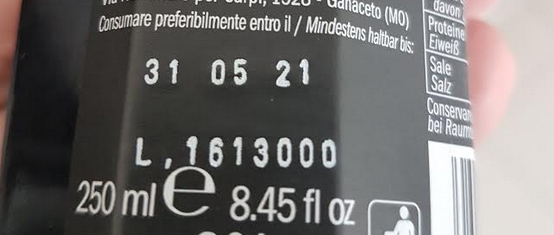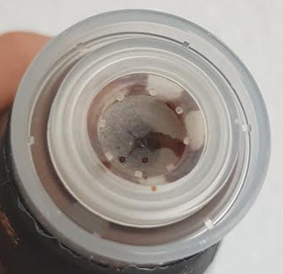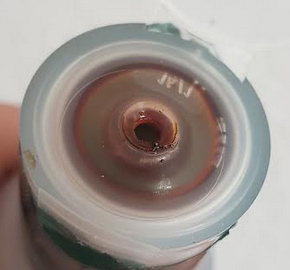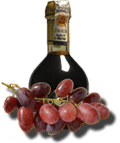A good balsamic vinegar usually has a few years to mature. The dark vinegar was stored in wooden barrels that were exposed to a wide variety of weather conditions in the cellars or attics of the vinegar winemakers and are only bottled at the end of the aging process.

Due to its acidity, vinegar has an almost unlimited shelf life, which is why it is also used to preserve other foods such as cucumbers, beans or peppers. Real traditional balsamic vinegar, not to be confused with an Aceto Balsamico di Modena or a condimento , does not usually have a best-before date and if it does, it is a maximum of 10 years. The vinegar regulationdoes not stipulate an expiry date (BBD) for this food, because it is assumed that a closed bottle of conventional vinegar can be kept for at least 10 years. If you now consider that a real traditional balsamic vinegar has matured in the barrel for 10 years, you can imagine that balsamic vinegar can hardly ever go bad in an airtight, sealed bottle. Caution , however, is industrially produced "Aceto Balsamico di Modena" or cheaper discount balsamic - without the "Vinegar" on the Ettiket- usually consists of several ingredients. The rule here is that the best-before date can vary widely. As a rule, it is around 3 years in the unopened state. The limited shelf life is often due to thickeners, added sugar or other chemical additives. Pure table vinegar or vinegar essence is even used to combat mold due to its acidity, i.e. against mold, as the molds are killed by the acid.
Nevertheless, balsamic vinegar can also "tip over"!
If the vinegar is kept open, it can tip over. However, even with an open bottle of balsamic vinegar, it can be assumed that the contents will keep for a very long time, as the acid deprives most bacteria of the basis of nutrition. If a real balsamic vinegar becomes moldy, then it is the cream yeast that forms on the surface. You can recognize them by their furry, bluish, light to light gray structure. Not to be confused with a so-called mother of vinegarwhich forms a yellowish carpet on the vinegar and arises from vinegar bacteria and can be used to obtain new vinegar. So far I have not seen any vinegar to which no additives whatsoever that has formed a creamy yeast. Kahm yeasts are often used and send me a picture to info@aceto-balsamico.com if you are unsure!
The situation is different with a balsamic vinegar with flavors or other additivessuch as corn starch, glucose or grape juice concentrate. These play a role in the shelf life and it can be assumed that these substances have a strong negative effect on the shelf life of the vinegar. Additives in vinegar, especially starches or sugar or sugar substitutes, mean that the best before date is often only reduced by up to two years. You can see in this picture what a moldy cheap balsamic vinegar looks like, where unfermented grape must was probably the cause.
If the balsamic vinegar smells bad and tastes musty when you taste it, then these are the first signs that the vinegar is no longer edible. In most cases, you can enjoy a real balsamic vinegar for at least 10 years.
Store balsamic vinegar correctly
A balsamic vinegar likes a place in the kitchen where it is not exposed to direct sunlight and where the room temperature is normal. Many vinegar winemakers in Modena also say that the real traditional balsamic vinegar should not be stored below 10 ° C. Basically, the bottle should be kept closed so that no vinegar flies or other animals can settle on the food. Even with traditional balsamic vinegar production, cloths are placed on the barrel opening so that the balsamic vinegar gets air, but no vinegar flies get into the barrel. Airtightness is therefore not a must when storing an original Aceto Balsamico Traditzionale.
You should also put the vinegar away from the fruit, as the evaporating vinegar oxidizes the fruit more quickly and thus makes it brown more quickly.
If smaller deposits or crystals form in the liquid, this is not a sign of poor quality or exceeded shelf life, but rather the opposite: The small crystals are mostly fructose deposits that are crystallized and form from the suspended matter in the vinegar. It indicates that the product is a natural product and was made without preservatives or additives. If the balm is still so watery that you can filter it, you can pour it through a coffee filter or a fine tea strainer and remove the deposits.
For balsamici that have been mixed with additives , it is always advisable to keep them closed and cool in the refrigerator after opening, as this makes it difficult for bacteria to develop. They usually like it warm.
Shelf life of crema balsamic vinegar
A balsamic vinegar cream is a dressing mixed with sugar and numerous other ingredients. The crema is not made exclusively from balsamic vinegar; in addition to glucose syrup and corn starch, it also often contains ingredients obtained from lemons, berries or fruit to give the crema balsamic vinegar a taste.
A crema di balsamic vinegar can often only be kept for a few weeks after opening, unless it has a diaphragm valve closure (squeezer) like you know from squeezable ketchup or barbecue sauce bottles. These let almost no air into the product and the substance in the bottle is less prone to mold formation. In this case, a balsamic cream also lasts significantly longer when refrigerated than stated on the best before date. Here is an example of an almost airtight closure of a balsamic cream from Mazetti: 
Closure - which protects the contents from the ingress of air and thus extends the shelf life on average 1 year compared to bottles without this type of closure.

Closure of a cheap balsamic cream without a membrane valve.
Other sources on the subject of the shelf life of balsamic vinegar on the web:













Aceto Balsamico Tradizionale
Matilde Piccinini, 136 pages
EUR (IT) 35,00
order now